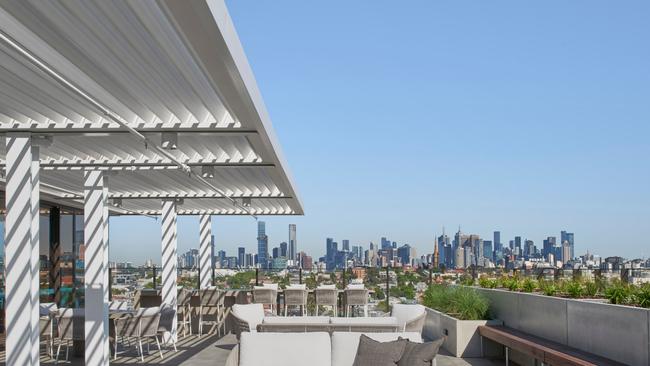Lavish retirement options as population ages
The nation’s population is ageing significantly, with more than a third of its residents now over the age of 50, a number projected to continue rising in the coming decades.

The nation’s population is ageing significantly, with more than a third of its residents now over the age of 50, a number projected to continue rising in the coming decades.
Statistics show that by the end of 2024, 35 per cent of the population consisted of people over 50, and this figure is expected to grow to 40 per cent in the next 30 years. This demographic shift has notable economic implications as a substantial portion of this age group holds considerable wealth, much of it tied up in real estate.
However, as these individuals get older and their children move out, maintaining large properties with extensive upkeep becomes less feasible and desirable.
Consequently, there is an emerging trend among this generation to seek homes that align with their evolving needs as they approach retirement.
Many are in search of luxurious, low-maintenance properties that come with a range of amenities and services designed to enhance comfort and enjoyment during their retirement years.
Developers have quickly recognised and capitalised on this demand by targeting the lucrative market of wealthy downsizers.
Historically, retirement living options were typically structured around village layouts, providing meals and varying levels of care tailored to residents’ age and health conditions.
However, the expectations of today’s retirees have broadened considerably, with many seeking more diverse and upscale living arrangements.
High-density vertical apartments in urban centres have gained popularity among retirees who wish to remain close to familiar neighbourhoods and enjoy the cultural buzz of city life.
Developers are increasingly appealing to affluent downsizers by offering luxury apartments that feature extensive in-house amenities such as cinemas, golf simulators, wine cellars and fine-dining restaurants.
An example of such a development is Ardency Kennedy Place in the Melbourne suburb of Richmond, which offers over-55s lush retirement living options, with prices starting at $1m. The facility includes resort-style amenities such as a private cinema and a wellness centre complete with an indoor heated pool.
The focus on the downsizer market extends beyond specific retirement developments.
The rising cost of construction, driven by increasingly expensive materials and a shortage of tradespeople, has rendered the construction of entry-level one and two-bedroom apartments economically unfeasible.
As a response, developers have shifted their attention to the downsizer market and affluent professionals, constructing luxurious three and four-bedroom apartments with state-of-the-art amenities and services.
Despite the fact that a majority (60 per cent) of enquiries for new apartment listings are focused on properties under $800,000, in December, 60 per cent of new apartment listings on realestate.com.au were priced at $800,000 or higher, a notable increase from 40 per cent two years prior.
Exemplifying this trend, EVA Palm Beach on the Gold Coast offers an array of high-end options with prices starting at $985,000 for two-bedroom apartments and reaching a staggering $3.5m for penthouse suites.
This trend is mirrored in the retirement living space.
Current retirement property listings on realestate.com.au span a wide range, from below $100,000 to over $4m, with most listings falling between $350,000 and $640,000. However, the most in-demand properties are those priced above $800,000.
Industry data reveals that the average age of residents in aged care is currently 80 years, with new entrants averaging 75 years.
This information indicates a burgeoning market for properties catering to younger retirees aged between 55 and 75.
Developers can attract this demographic by offering luxury apartment living options in highly desirable locations, encouraging earlier transitions into retirement living.
Watermark Residences in Chatswood, NSW, stands as an example, featuring two, three and four-bedroom apartments starting at $2m.
These offer breathtaking views of the 12-hole golf course, as well as access to premium facilities like the indoor hydrotherapy pool, gym, wellness centre and movie theatre.
For many Australians over 50, the substantial equity tied up in their family homes positions them well to afford a downsize to luxurious retirement residences.
Many individuals within this age group might not be retired but opt for communities like Watermark to enjoy a refined lifestyle.
Similar developments, such as Palm Lake Resort in Pelican Waters, Queensland, offer secure, gated communities featuring golf courses, country clubs and complimentary golf carts with each property purchase.
These premium retirement options are experiencing surging demand, with inquiries for properties over $800,000 increasing significantly over the past two years, in contrast to a sharp decline in enquiries for cheaper options.
The greatest increase in demand is observed in properties priced between $1m and $2m.
The market has seen a significant shift towards larger and more expensive new developments since the pandemic, often at the expense of affordable housing options.
However, given the growing demand for luxury living, it is expected that more large downsizer apartments and resort-style retirement villages will continue to be constructed in abundance, catering to the evolving preferences of this affluent demographic for the foreseeable future.



To join the conversation, please log in. Don't have an account? Register
Join the conversation, you are commenting as Logout